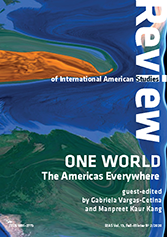WORKS CITED
Google Scholar
Albright, Ann Cooper. Choreographing Difference: The Body and Identity in Contemporary Dance. Wesleyan UP, 1997.
Google Scholar
Allen, Matthew Harp. “Rewriting the Script for South Indian Dance.” TDR, vol.41, no. 3, Autumn, 1997, pp. 63-100, https://www.jstor.org/stable/1146609. Accessed 21 April 2019.
Google Scholar
Artham: Exploring Diasporic Bharatnatyam. Directed by Sweta Devarajan and Meera Murti. 2016. https://www.youtube.com/watch?v=AHU18I2GddU.
Google Scholar
Arundale, Rukmini. “Bhava, Raga, Tala.” Accelerated Motion: Towards a New Dance Literacy. Bodies and Society. 1948. https://www.oberlinlibstaff.com/acceleratedmotion/primary_sources/texts/bharatanatyam/bhava_raga.pdf. Accessed 6 May 2019.
Google Scholar
Banerjee, Suparna. “Adaptation of Bharatanatyam Dance Pedagogy for Multicultural Classrooms: Questions and Relevance in a North American University Setting.” Research in Dance Education, vol.14, issue 1, 2013, published online 24 Aug 2012, pp. 20-38, https://doi.org/10.1080/14647893.2012.712102. Accessed 16 May 2019.
Google Scholar
Butler, Judith. “Performative Acts and Gender Constitution: An Essay in Phenomenology and Feminist Theory.” Theatre Journal 40(4), Dec. 1988, pp. 519-531.
Google Scholar
Chakravorty, Pallabi. Bells of Change. Kathak Dance, Women and Modernity in India. Seagull Books, 2008.
Google Scholar
Dattani, Mahesh. Dance Like a Man: A Stage Play in Two Acts. Penguin India, 2006.
Google Scholar
Goldberg, Herb. “The Gender Trap: How Far We Have, and Haven't, Come in Transcending Traditional Gender Programming.” Context Institute: Catalyzing a Graceful Transition to a Sustainable Planetary Future. Summer 1985, https://www.context.org/iclib/ic10/goldberg/. Accessed 14 Feb. 2019.
Google Scholar
Govind, Priyadarsini. Interview by KutcheriBuzz. “I Knew Where I Wanted to Go . . . ,” http://www.kutcheribuzz.com/kb-special/kb-interviews/1110-priyadarsini-govind
Google Scholar
Jain, Jasbir. Writers of Indian Diaspora: Theory and Practice. Rawat Publications, 2011.
Google Scholar
“Kamala Lakshmi Narayanan: Bharatanatyam Indian Dancer.” NEA National Heritage Fellowships, National Endowment for the Arts, https://www.arts.gov/honors/heritage/fellows/kamala-lakshmi-narayanan. Accessed 26 April 2019.
Google Scholar
Katrak, Ketu H. “’Cultural Translation’ of Bharata Natyam into ‘Contemporary Indian Dance.’ Second‐Generation South Asian Americans and Cultural Politics in Diasporic Locations.” South Asian Popular Culture, vol. 2, issue 2, 2004, published online 7 Aug 2006, pp.79-102, https://doi.org/10.1080/1474668042000275699. Accessed 20 April 2019.
Google Scholar
Kumar, Anita. “Bharatanatyam and Identity Making in the South Asian Diaspora: Culture through the Lens of Occupation.” Journal of Occupational Science, vol. 18, no. 1, published online 31 Mar 2011, pp. 36-47. https://doi.org/10.1080/14427591.2011.554152. Accessed 20 April 2019.
Google Scholar
Lakshman, Kamala. Interview by Lalitha Venkat. “Kamala Lakshman, Bharatanatyam Dancer & Guru.” Narthaki: Your Gateway to the World of Indian Dance, Founder and Managing Editor, Anita Ratnam, Aug 2000, https://narthaki.com/info/intervw/intrvw4.html. Accessed 12 March 2019.
Google Scholar
Minai, Cassidy. “Meeting and Interviewing Kamala! And a Rare Video Find at the NYPL!” Cinema Nritya, http://cinemanrityagharana.blogspot.com/2014/05/meeting-and-interviewing-kamala-and.html. Accessed 14 March 2019.
Google Scholar
Mitra, Royona. 2006. “Living a Body Myth, Performing a Body Reality: Reclaiming the Corporeality and Sexuality of the Indian Female Dancer.” Feminist Review, 84:1, Oct. 2006, pp. 67-83, https://doi.org/10.1057/palgrave.fr.9400301. Accessed 6 March 2019.
Google Scholar
Nair, Malini. “The Problem of Groping Gurus and Silent Shishyas.” Sunday Times of India, New Delhi, 20 Sep. 2020.
Google Scholar
Narayan, R.K. The Guide. Penguin Books, 1958.
Google Scholar
Narayan, Shovana. The Sterling Book of Indian Classical Dances. New Dawn Press, 2005.
Google Scholar
O’Shea, Janet. “Tradition and the Individual Dancer.” Accelerated Motion: Bodies and Society. pp. 26-69. https://www.oberlinlibstaff.com/acceleratedmotion/primary_sources/texts/bharatanatyam/tradition_individual.pdf. Accessed 16 April 2019.
Google Scholar
Pandeya, Tara Catherine. “Dances of the Central Asian Silk Road” https://taradances.weebly.com/
Google Scholar
Pandeya, Tara Catherine. “Tara Catherine Pandeya: Dance.” https://www.facebook.com/TaraCatherinePandeya/
Google Scholar
Peth, Simon. “What is Translocality? A Refined Understanding of Place and Space in a Globalized World.” Connecting the Spots: Notes on Migration and Environment from a Geographical Perspective, 2018, http://www.transre.org/index.php/blog/what-translocality-refined-understanding-place-and-space-globalized-world. Accessed 12 March 2019.
Google Scholar
Puri, Rajika. “Bharatanatyam Performed: A Typical Recital.” Visual Anthropology, 17:1, 2004, pp. 45-68, DOI: 10.1080/08949460490274022. Accessed 30 April 2019.
Google Scholar
Ramberg, Lucinda. Given to the Goddess: South Indian Devadasis and the Sexuality of Religion. Duke UP, 2014.
Google Scholar
Rathore, Reena. “Indian American Dancer Building Cultural Bridges Through Dance.” India West: Best Indian Newspaper in Print and Online. 13 October 2017. https://www.indiawest.com/entertainment/global/indian-american-dancer-building-cultural-bridges-through-dance/article_b9826028-af93-11e7-af97-ef3893c6445f.html. Accessed 16 Feb. 2019.
Google Scholar
Ratnam, Anita. Interview by Lalitha Venkat. “Anita Ratnam: I am not an Export Artiste,” Narthaki: Your Gateway to the World of Indian Dance, Founder and Managing Editor, Anita Ratnam, 3 December 2008, http://www.narthaki.com/info/intervw/intrv109f.html8. Accessed 24 March 2019.
Google Scholar
Sabhash. “Priyadarsini Govind: Bharatanatyam Dancer, Tamil Nadu, India.” http://www.sabhash.com/artist/57/priyadarsini-govind.htm#:~:text=Priyadarsini%20Govind%20is%20one%20of,Pillai%20and%20Padma%20Bhushan%20Smt.&text=In%20her%20career%2C%20spanning%20two,over%20India%20and%20the%20globe. Accessed 10 September 2020.
Google Scholar
Srinivasan, Priya. Sweating Saris: Indian Dance as Transnational Labor. Temple UP, 2012.
Google Scholar
“United States Immigration Policy in the Early 20th Century.” The Workmen’s Circle, J Source, http://circle.org/jsource/united-states-immigration-policy-in-the-early-20th-century/. Accessed 20 March 2019.
Google Scholar
Whitehead, Judith. “Community Honor/Sexual Boundaries: A Discursive Analysis of Devadasi Criminalization in Madras, India, 1920-1947.” Accelerated Motion: Bodies and Society, pp. 91-106, https://www.oberlinlibstaff.com/acceleratedmotion/dancehistory/bharatanatyam/section5.php, Accessed 23 March 2019.
Google Scholar


 https://doi.org/10.31261/rias.9884
https://doi.org/10.31261/rias.9884

 10.31261/RIAS
10.31261/RIAS